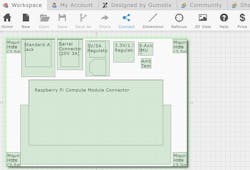Gumstix Geppetto is a web-based carrier-board design tool that I’ve covered before. It allows a developer to design a printed circuit board without worrying about the board’s physical connections. Objects that can be placed on the board are from a limited selection, but it includes a number of different processor modules such as NVIDIA’s Jetson.
Geppetto is very easy to use. Its drag-and-drop interface lets you effortlessly add items from processors to sensors to connectors. A compact design can be done by moving items around to optimize real-estate usage. There are some placement limitations when using high-speed interfaces like USB 3, but most items like sensors and voltage regulators can be placed anywhere.
One challenge using Geppetto is determining what items to include and how they might relate to each other. The system already tracks connections and indicates, by color, whether all requirements for an item are fulfilled. For example, a memory chip requires power and a memory interface on a processor. The chip is initially red and then green when these connections are done.
Making the connections is a matter of clicking on an item’s requirement list entry, such as the memory chip, and then the matching item, the processor. Sometimes there will be only one match, sometimes multiple possibilities. If there are none, Geppetto provides a list of items that can be added to fulfill this requirement.
1. Board Builder uses a simple selection menu to start the design process.
Board Builder (Fig. 1) is Gumstix’s latest addition to Geppetto that further simplifies the design process. A developer selects zero or more items of each type, including processors/COM modules, sensors, audio, memory, network, USB or miscellaneous items. The size of the board and optional mounting holes can be selected at this time.
Board Builder then builds a Geppetto project. It also computes the amount of power required and provides options to provide it. Board Builder then connects most of the items together, including power. Though connectors are placed the edge of a board, most components are just distributed around the board. Geppetto is then used to do any final positioning as well as make any corrections or additions (Fig. 2). A green board is ready to be built.
2. Board Builder generates a Geppetto project that can then be customized by repositioning objects as well as adding or modifying the generated design.
The part I haven’t mentioned yet is that for a setup charge of just under $2,000, Gumstix will deliver fully populated boards. Geppetto provides the final price as well as the cost of each item. The setup cost may be high if you need just a few boards; however, if you need more and will not be making tens of thousands, then Gumstix’s solution will be much less expensive. Boards are delivered in a few weeks. The tool can also generate a bill of materials, documentation, and board-support packages for software developers.
Not every COM module or processor or sensor can be included in a design, but there are lots to choose from, such as processors like Microchip’s ATmega32U4, an STMicro Cortex-M4, NXP’s SCM, or a number of Texas Instruments’ Sitara family members. Support for most major wireless technologies. including Wi-Fi, Bluetooth, and LoRaWAN, are available.
Geppetto is ideal for designing and delivering gateways and end devices for the Internet of Things (IoT). It can even be economical as a short-run prototyping solution. Testing an IoT system with only a couple of devices is rarely sufficient.
Coming up with a custom board can be done with lots of in-house expertise, farming out the job to a third party, or using a tool like Geppetto and Board Builder. Short of having boards delivered, developers can try out all of Geppetto’s features for free. It’s worth trying the system given how little time it takes to create a solution. The end result is a known configuration and cost that will be hard to beat.




